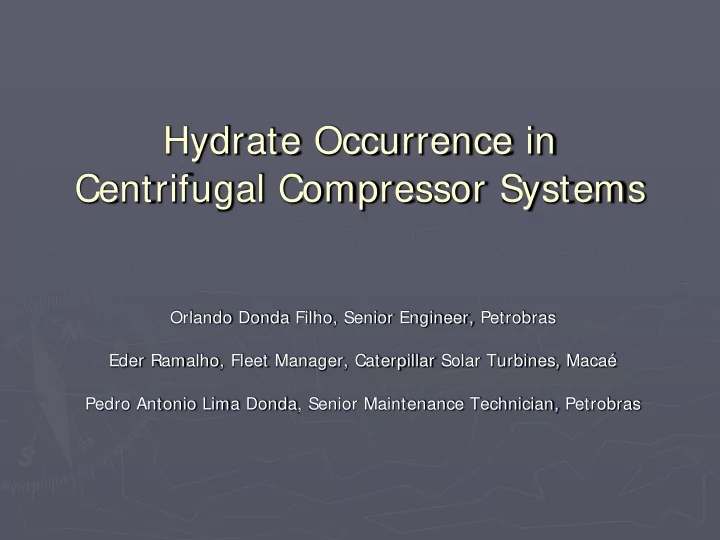

Hydrate Occurrence in Centrifugal Compressor Systems Orlando Donda Filho, Senior Engineer, Petrobras Eder Ramalho, Fleet Manager, Caterpillar Solar Turbines, Macaé Pedro Antonio Lima Donda, Senior Maintenance Technician, Petrobras
Hydrate Occurrence in Centrifugal Compressor Systems Hydrates are composed of water and light hydrocarbons in a solid • matrix that resembles ice. They are formed at low temperatures such as downstream of throttling a high pressure, saturated gas across a control valve. Hydrate formation is not easily detectable in compressor systems • because instrumentation and protective controls are not normally provided for this purpose. Hydrate leaves no trace, when systems are examined for the • potential cause, the temperature and pressure are normally at ambient conditions and the hydrates have evaporated. Control strategies should be developed and devices should be • provided to detect and avoid damaging hydrate formation in compressor systems. There have been a number of compressor repairs required where • the root cause of failure has not been clearly identified.
Hydrate Occurrence in Centrifugal Compressor Systems Hydrates Envelope - Hydrate composition is basically water and methane. Other compounds may occur in quantities no greater than 2 %. Most common area of hydrate formation observed Natural Gas Hydrate Equilibrium Curve Courtesy of Petrobras
Hydrate Occurrence in Centrifugal Compressor Systems Compressor Train Configuration
Hydrate Occurrence in Centrifugal Compressor Systems Brief history of compressor failure: Compressor was re-started after maintenance activity completed at • 20:44 hours. Field operator went to visually inspect compressor shortly after start- • up and noted smoke coming from discharge piping. Operator returned to control room and noted the HP unit discharge • temperature was 734 F . Operator notified maintenance team. By the time the maintenance • personnel arrived to the control room, the compressor discharge had risen to 932 F . Compressor was shut down at 20:59 hours. • A re-start was attempted but was unsuccessful because the rotor was • locked.
Hydrate Occurrence in Centrifugal Compressor Systems ZE-221501 – HP Axial Displacement XE-221501-H – HP NDE Vibration Horizontal PT-22147 – HP Discharge Pressure XE-221502-H – HP DE Vibration Horizontal TT-22104 – HP Suction Temperature TT-22134 – HP Discharge Temperature PT-22143 – HP Suction Pressure TT 22136 – LP Discharge Temperature
Hydrate Occurrence in Centrifugal Compressor Systems Event Trend Analysis Discharge Pressure Discharge Temperature Decreasing Rising Low Energy Surge Suction Temperature Almost Constant But 30% Lower Vibration with Abnormal Behavior Shaft Axial Displacement Event Total Time 15 minutes Event Beginning High Frequency Compressor Stopped 20:44 hours 20:59 hours
Hydrate Occurrence in Centrifugal Compressor Systems Compressor Internals Inspection HP Shaft Thrust Bearing End HP Thrust and Radial Bearing No Visible Damage Radial Bearing Shaft Position No Visible Damage
Hydrate Occurrence in Centrifugal Compressor Systems Compressor Internals Inspection Diaphragms Deformed Labyrinth Seals Melted and Impellers Damaged
Hydrate Occurrence in Centrifugal Compressor Systems Compressor Internals Inspection In general, the damage was caused by high temperature estimated to be approximately 1,112 F (600 C)
Hydrate Occurrence in Centrifugal Compressor Systems Hydrate formation in the suction side of a compressor may result in the following: - Reduction in suction temperature. - Reduction in discharge pressure. - Reduction in compressor flow. - Low energy surge (the most dangerous event). - Increase in discharge temperature.
Hydrate Occurrence in Centrifugal Compressor Systems Why didn’t the Protection System work properly? - Failure of high discharge temperature switch. - Pneumatic Anti-Surge Detector didn’t work in presence of low energy surge. - Anti-Surge Control System did not include any fallback strategies for instrument failure. - Vibration not high enough to activate vibration shutdown. - Surge condition not possible to be recognized by Operators. - Low suction temperature control not implemented.
Hydrate Occurrence in Centrifugal Compressor Systems How Can Hydrate Formation Be Prevented - Maintain operation within the design range. - Provide active suction temperature control with existing coolers. - Provide low suction temperature alarm when operation approaches the border of hydrate envelope. - Use process transmitters instead of switches to improve process control reliability and reduce failure potential. - Review surge control system control strategies including fallback (or instrument failure) strategies.
Hydrate Occurrence in Centrifugal Compressor Systems Where Are Hydrates Commonly Found - Upstream oil & gas primary separation facilities where water saturated gas may be processed. - Suction permanent and temporary filters. - Anti-Surge loop piping, upstream and downstream of compressor control valves, depending upon pressure and temperature. - Balance line in back-to-back compressor designs.
Hydrate Occurrence in Centrifugal Compressor Systems Three Final Recommendations 1 - Spend time during the engineering phase to avoid layout mistakes. After installation any required changes are much more difficult and costly, if not impossible, to achieve. 2 – Use cooler control logic as illustrated to enhance suction temperature control system. Temperature Logic Control for Cooler P1 Temperature Logic Control for Cooler P2
Hydrate Occurrence in Centrifugal Compressor Systems Third and Last Recommendation In case of potentially unsafe operating conditions combined with an unknown control systems strategy, use ODCCPL logic inserted at PLC as described below: ► If compressor RPM = > 90%; Flow < = 20% ; Time > 10 seconds; Then Shutdown. Signaling in the control panel: Suction low flow or blocked Suction. ODCCPL means: Orlando Donda Centrifugal Compressors Protection Logic.
Hydrate Occurrence in Centrifugal Compressor Systems The End. Thank You.
Recommend
More recommend